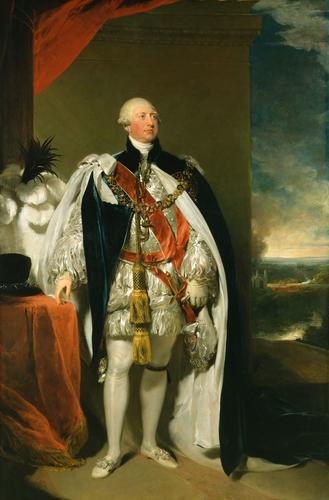-
1 of 253523 objects
George III (1738-1820) 1818-23
Oil on canvas | 269.8 x 177.8 x 3.6 cm (support, canvas/panel/stretcher external) | RCIN 404932
-
Lawrence was the most fashionable and also the greatest portraitist of his generation. He was made Principal Painter to George III in 1792 after Reynolds’s death, and received occasional commissions; however it was only after 1814 that George IV began to employ him in earnest.
This is a repetition of the full-length portrait painted for the City of Coventry (exhibited at the Royal Academy in 1792 and now in the Herbert Art Gallery, Coventry). The King is shown in Garter robes, resting his right on a table beside the hat of the Order. A landscape with the Thames and east end of Eton College Chapel can be seen in the background. The way in which the King looks upwards, as if bent on some noble (perhaps even sacred) purpose, is entirely characteristic of Royal imagery at this date.
This version was painted for George IV during the years 1818-23 and originally place in the Throne Room of St James Palace between the two Jones battle scenes (RCIN 407186-7). It was sent to Windsor in 1829 but is only recorded at the Waterloo Chamber in 1837.
The Waterloo Chamber is a great hall on the public route at Windsor Castle displaying portraits of those soldiers, sovereigns and diplomats responsible for the overthrow of Napoleon and the re-establishment of the monarchies and states of Europe thereafter. The concept began in 1814 when George IV used the opportunity of the Treaty of London to commission Lawrence to paint distinguished visitors. The group of portraits grew during the next decade as Lawrence continued to obtain portrait sittings at the various congresses following the Battle of Waterloo in 1815 and, in some cases, by making special journeys. Most of the twenty eight portraits were delivered after his death on 7 January 1830. By this time work was already begun of the space of the Waterloo Chamber created by covering a courtyard at Windsor Castle with a huge sky-lit vault; the room was completed during the reign of William IV (1830-7). The first illustration of the interior is provided by Joseph Nash (1809-78) in 1844 (RCIN 919785) and shows the arrangement which survives to this day: full-length portraits of warriors hang high, over the two end balconies and around the walls; at ground level full-length portraits of monarchs alternate with half-lengths of diplomats and statesmen.Provenance
Commissioned by George IV; taken from the overmantle in the Entree Room at St James's Palace to Windsor Castle in June 1829; recorded hanging in the Waterloo Chamber in 1868
-
Medium and techniques
Oil on canvas
Measurements
269.8 x 177.8 x 3.6 cm (support, canvas/panel/stretcher external)
263.0 x 173.3 cm (sight)
264.6 x 172.2 cm (sight)
Category
Object type(s)
